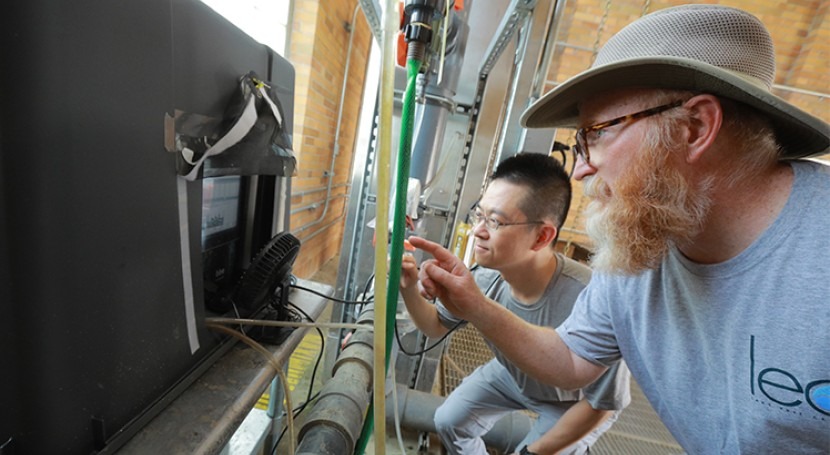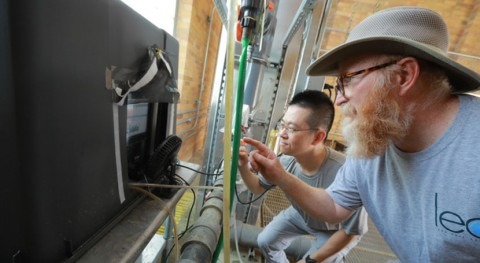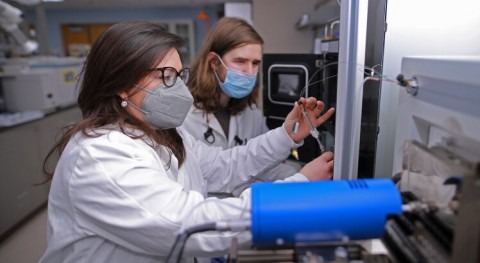Advanced technology tested nearly two years ago in the water treatment system that serves Toledo could prove valuable in efforts to protect the water that pours out of taps well beyond northwest Ohio, according to research published by The University of Toledo.
UToledo scientists installed a real-time algae sensor at the Toledo low service pump station in eastern Lucas County in 2022 as part of a wider-reaching initiative aimed at the early detection and management of harmful algal blooms sponsored by the U.S. Army Corps of Engineers. The installation put the facility on the map as the first in the nation to test out the fluorescence-based technology that detects a pigment that scientists believed could flag the release of toxins from blue-green algal cells.
In research published recently in the peer-reviewed journal Science of the Total Environment, their analysis of the resulting data confirms that the technology worked as intended.
“The instrument is able to detect blue-green algal cell lysis in real time, providing an early warning of potentially elevated levels of microcystin toxin in the raw water supply,” said Dr. Kuo-Pei Tsai, lead author on the article and a postdoctoral associate at the UToledo Lake Erie Center. “That means the water treatment plant staff could immediately begin to take precautions if another catastrophic occurred like the one in 2014.”
Scientists now have ample tools to detect and monitor harmful algal blooms, which in Lake Erie are caused by cyanobacteria, also called blue-green algae. Harmful algal blooms have been a focus of particularly intense research since the Toledo water crisis that left half a million residents without safe tap water for three days in 2014.
But one complicating factor water plant managers face is that harmful algal blooms are not uniformly harmful. Most of the time, intact cyanobacterial cells can be easily filtered from incoming water along with their toxins. When the cells start to break down, however, their toxins are released into the water, requiring managers to apply chemical treatments to absorb or destroy the toxins.
The breakdown process is called lysis. It can result from outbreaks of naturally occurring viruses in the environment, called cyanophages, as scientists hypothesize happened during the 2014 water crisis, or through the application of algaecides or water treatment chemicals. When cyanophages attack a bloom, large pulses of toxin can be released in a matter of hours.
Traditionally, water treatment plant operators have relied on relatively slow and costly assays to directly monitor both cell-bound and free toxin levels in the water. The PhycoSens, the device produced by German company bbe Moldaenke and installed at the pump station by the UToledo Lake Erie Center, complements but does not replace these assays by detecting in real time a byproduct of cyanobacterial lysis: a pigment called unbound phycocyanin.
Scientists hypothesized that the detection of the pigment would serve as an indicator that cyanobacterial cell membranes are breaking down and potentially releasing microcystin, and that the instrument’s reports on water samples taken every quarter-hour during the harmful algal bloom season would alert operators to jump into action.
“The instrument will allow water treatment plant operators to see when the condition of a harmful algal bloom in their source water is changing rapidly and to respond appropriately,” said Dr. Thomas Bridgeman, professor of ecology and director of the UToledo Lake Erie Center and senior author of the research article. “Without real-time data of this kind, the conservative approach may be to overtreat water with chemicals to ensure safety, which adds expense and can detract from water’s taste. This technology will allow treatment plant operators to better match their responses to the severity of the situation, saving money and improving taste while still providing a high level of safety.”
The Phyco-Sens took samples between mid-July and mid-October in 2022, offering researchers a vast cache of data to analyze. Additional laboratory studies with cyanobacteria, treatment chemicals and cyanophages helped them to reach the conclusion is that the presence of unbound phycocyanin is indeed a useful indicator of the onset of cyanobacterial cell lysis and in turn the potential release of microcystin.
The device’s purchase, installation and related research are funded through a $1.4 million grant to develop enhanced technology for early detection and management of harmful algal blooms through U.S. Army Corps of Engineers.
Dr. Youngwoo Seo, professor in the Department of Civil and Environmental Engineering and Chemical Engineering, leads the three-year project that began in 2021. Dr. Dae-Wook Kang, assistant professor in the same department, joins Bridgeman as a co-investigator.
The researchers and their collaborators are working with municipal drinking water treatment plants in Bowling Green, Celina and Oregon in addition to Toledo, where the Phyco-Sens is deployed again this year and already taking samples ahead of the harmful algal bloom season.









